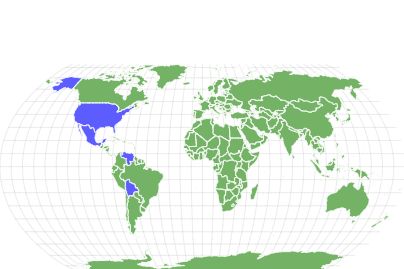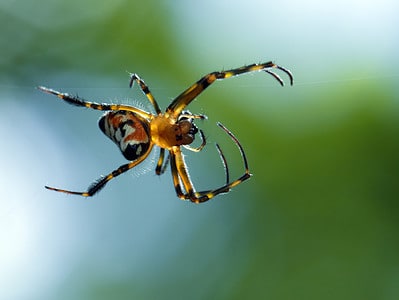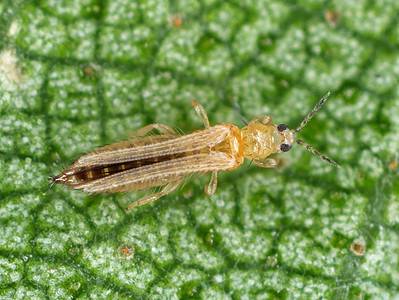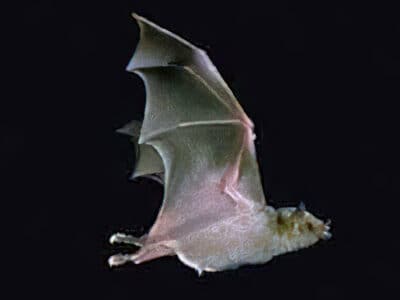Orchard Oriole
Icterus spurius
They use rapid wingbeats to hover over foliage as they search for food.
Advertisement
Orchard Oriole Scientific Classification
- Kingdom
- Animalia
- Phylum
- Chordata
- Class
- Aves
- Order
- Passeriformes
- Family
- Icteridae
- Genus
- Icterus
- Scientific Name
- Icterus spurius
Read our Complete Guide to Classification of Animals.
Orchard Oriole Conservation Status
Orchard Oriole Facts
- Prey
- Insects, spiders, pollen, nectar, berries, and flowers
- Main Prey
- Insects
- Name Of Young
- Chicks
- Group Behavior
- Social
- Fun Fact
- They use rapid wingbeats to hover over foliage as they search for food.
- Estimated Population Size
- Unknown
- Biggest Threat
- habitat loss, cowbird parasitism, and overgrazing
- Most Distinctive Feature
- Chestnut and black coloring
- Distinctive Feature
- sharply pointed bills
- Other Name(s)
- Ochre oriole, Fuertes's oriole
- Wingspan
- 9.8 inches
- Incubation Period
- 12 to 15 days
- Age Of Fledgling
- 11 to 14 days
- Habitat
- Orchards, wood edges
- Predators
- crows, owls, squirrels, foxes, and domestic cats
- Diet
- Omnivore
- Lifestyle
- Diurnal
- Type
- Bird
- Common Name
- Orchard oriole
- Number Of Species
- 3
- Location
- North America, South America
- Nesting Location
- Tree fork, tall shrub
- Age of Molting
- 2 years
- Migratory
- 1
View all of the Orchard Oriole images!
“They are easy-going birds who show little aggression toward other bird species.”
Summary
The orchard oriole (Icterus spurius) is a small passerine bird native to North and South America, inhabiting orchards and woodland edges. These social birds are easy-going and show little aggression, often joining mixed-species groups. Listen for the male’s rapid musical songs during spring when he courts his mate. Discover all the interesting facts about this oriole, including where it lives, what it eats, and how it behaves.
5 Amazing Orchard Oriole Facts
- Females form hanging pouches or baskets out of plant fiber as their nests.
- Their songs sound similar to a purple finch but lack rich quality.
- They use rapid wingbeats to hover over foliage as they search for food.
- Parents mob intruders who get too close to their nest.
- They face threats such as habitat loss and cowbird parasitism.
Where to Find the Orchard Oriole
Orchard orioles live in North and South America in 14 countries, including Canada, the United States, Mexico, Venezuela, and Bolivia. They spend their springs and summers in the eastern half of the United States and central Mexico, migrating mid-summer to their wintering grounds in Central America and the northern tip of South America (Colombia, Venezuela). Their breeding habitats include semi-open areas, such as orchards and wood edges; they winter in the lowland tropic’s brushy areas. They may also inhabit suburbs, prairie groves, and riverside trees.
Countries
- Canada
- Belize
- The United States
- Costa Rica
- Colombia
- El Salvador
- Guatemala
- Honduras
- Mexico
- Nicaragua
- Panama
- Turks and Caicos Islands
- Venezuela
- Bolivia
Orchard Oriole Nest
They nest in deciduous trees or tall shrubs in the fork of a horizontal branch, sometimes around clumps of Spanish moss. Females build hanging baskets made from grass and plant fiber and lined with fine grass and plant down.
Scientific Name
The orchard oriole (Icterus spurius) belongs to the Passeriformes order in the Icteridae family, which encompasses the New World blackbirds. The Icterus genus includes the New World orioles and is sometimes mistaken for New World warblers. There are three recognized subspecies of orchard oriole.
Size, Appearance, & Behavior
The orchard oriole is a small passerine bird, measuring 5.9 to 7.1 inches and weighing 0.6 to 1.0 ounces, with a 9.8-inch wingspan. They have sharply pointed bills, medium-length tails, and round heads. Adult males have chestnut underparts and rumps, and the remaining plumage is black. They also have black bills and white wingbars.
This species is relatively social, forming pairs during the breeding season and foraging and roosting in groups during the winter. They are easy-going birds who show little aggression toward other bird species. Males are most vocal during the spring, and their songs are rapid, musical warbles similar to a purple finch. They are light, agile fliers that produce rapid wingbeats and may hover over foliage to search for food.
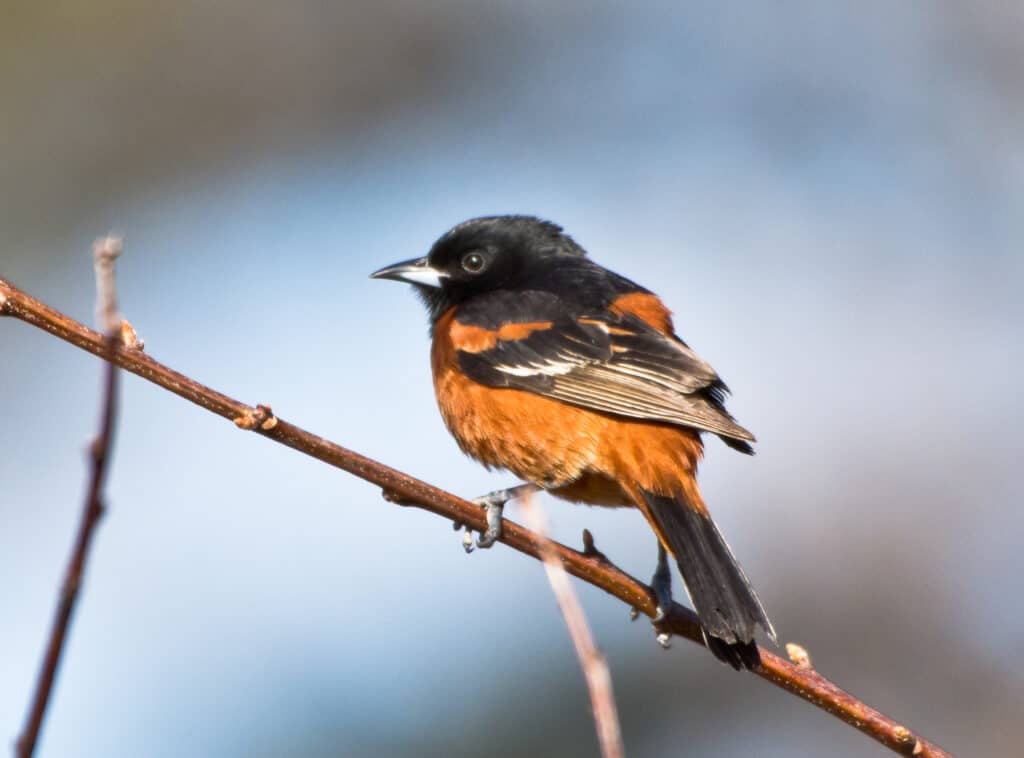
Orchard oriole males have chestnut bodies, and their remaining plumage is black.
©iStock.com/Irving A. Gaffney
Migration Pattern and Timing
Orchard orioles are long-distance migrants, arriving on their breeding grounds in late May and leaving by mid-July. They breed in the eastern half of the United States and central Mexico, migrating through northern Mexico and northern Central America before reaching their wintering grounds in Central America and the northern tip of South America.
Diet
The orchard oriole is an omnivore who primarily eats insects but supplements with fruit and plant material.
What Does the Orchard Oriole Eat?
Their diet consists of beetles, grasshoppers, caterpillars, spiders, wasps, ants, nectar, pollen, berries, and parts of flowers. They mainly eat insects during the summer but supplement with berries, nectar, and other plant material during the winter. They forage among the foliage of trees and bushes, probing flower blossoms and snatching insects. This species feeds in flocks during winter.
Predators, Threats, and Conservation Status
The IUCN lists the orchard oriole as LC or “least concern.” Due to its extensive range and very large, stable population, this species does not meet “threatened” status thresholds. However, these birds still face threats in certain parts of their range, such as habitat loss, cowbird parasitism, and overgrazing which destroys shrub vegetation.
What Eats the Orchard Oriole?
Their predators include crows, owls, squirrels, foxes, and domestic cats. These predators typically target their eggs and young, but parents will defend their nests. Orioles use alarm calls to warn of potential danger and will mob intruders who get too close.
Reproduction, Young, and Molting
Orchard orioles form monogamous pairs during the spring but will change partners each year. This species is not very territorial, and more than one pair may nest in the same tree. Females lay an average of four to five pale bluish-white eggs with brown and gray spots. She incubates them for 12 to 15 days while males bring food. Both parents feed the nestlings, and the young fledge the nest 11 to 14 days after hatching, but they remain with one or both parents for several more weeks. They become sexually mature and acquire their adult plumage around two years and live an average of five years.
Population
The global orchard oriole population is unknown, but they have had stable numbers in North America for the last 40 years. They are not experiencing any extreme fluctuations or fragmentations in their population.
Related Animals:
View all 66 animals that start with OOrchard Oriole FAQs (Frequently Asked Questions)
Where are orchard orioles found?
Orchard orioles live in North and South America in 14 countries. Their breeding habitats include semi-open areas, such as orchards and wood edges; they winter in the lowland tropics brushy areas.
What does the orchard oriole eat?
Their diet consists of beetles, grasshoppers, caterpillars, spiders, wasps, ants, nectar, pollen, berries, and parts of flowers.
How big are orchard orioles?
The orchard oriole is a small passerine bird, measuring 5.9 to 7.1 inches and weighing 0.6 to 1.0 ounces, with a 9.8-inch wingspan.
What do orchard orioles sound like?
Males are most vocal during the spring, and their songs are rapid, musical warbles similar to a purple finch.
What threatens the orchard oriole?
Their biggest threats include habitat loss, cowbird parasitism, and overgrazing which destroys shrub vegetation.
What are orchard oriole predators?
Their predators include crows, owls, squirrels, foxes, and domestic cats.
How many eggs do orchard orioles lay?
Females lay an average of four to five pale bluish-white eggs with brown and gray spots.
Thank you for reading! Have some feedback for us? Contact the AZ Animals editorial team.
Sources
- IUCN Redlist, Available here: https://www.iucnredlist.org/species/103793298/94850686
- PNAS.org, Available here: https://www.pnas.org/doi/abs/10.1073/pnas.0908121106
- MBR, Available here: https://www.mbr-pwrc.usgs.gov/id/framlst/i5060id.html

